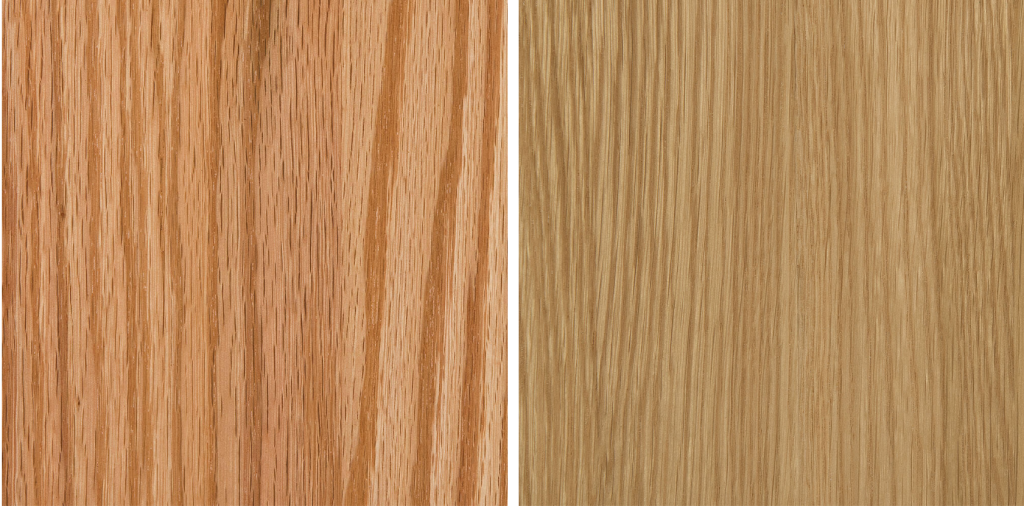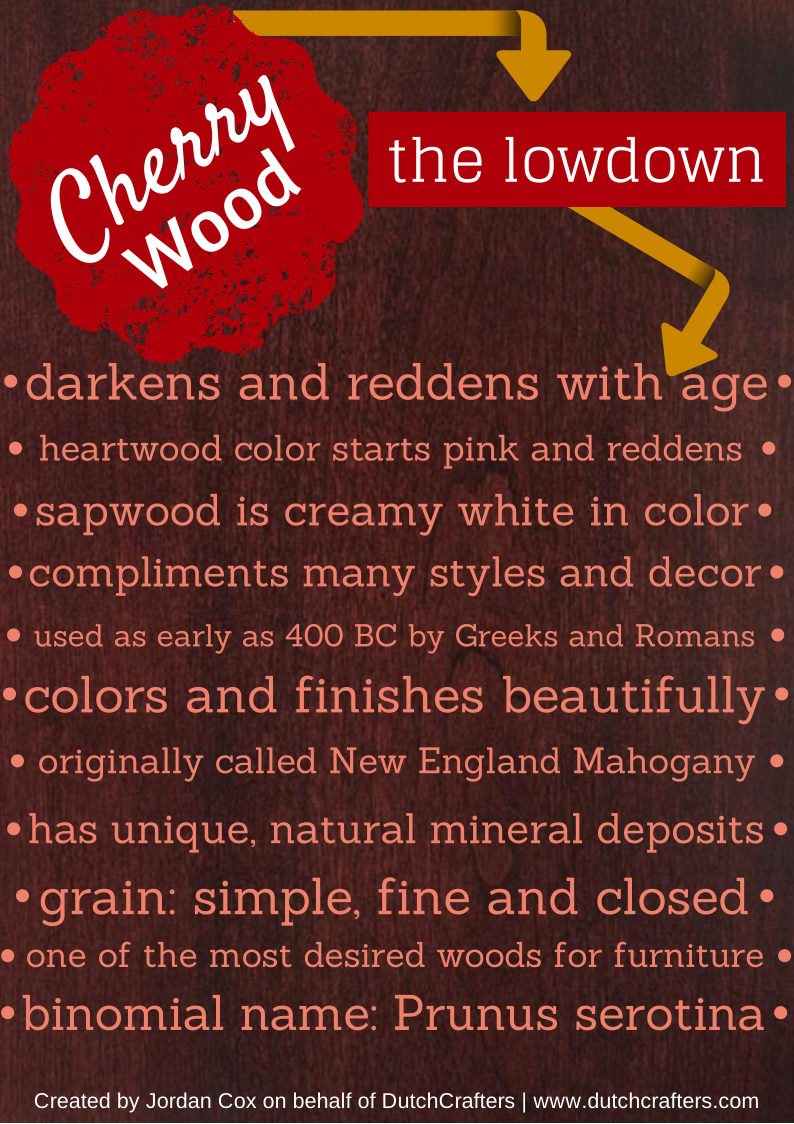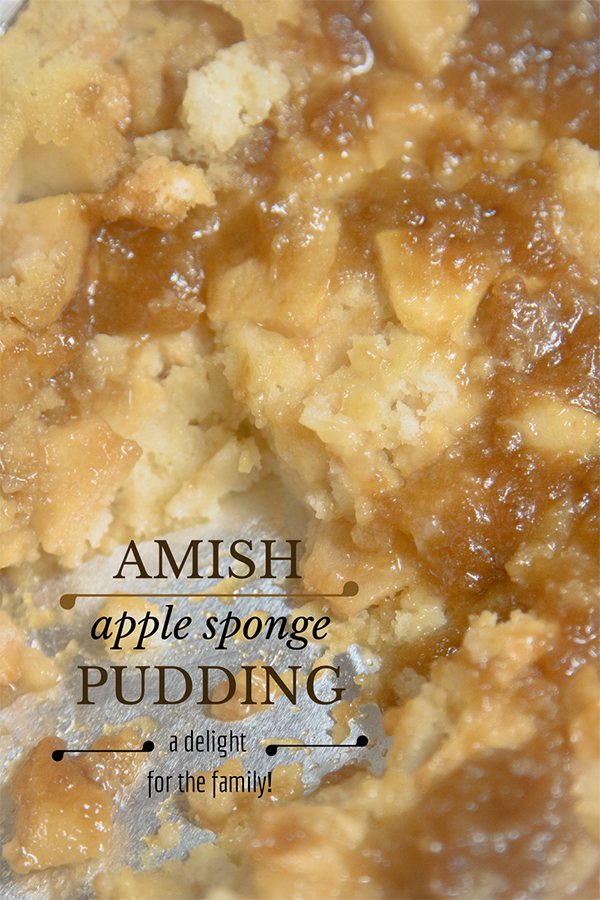
Red Oak vs. White Oak: What’s the Difference?
When most people talk about “oak furniture,” they are referring to red oak. Unfinished red oak has a slight pinkish hue, and white oak has a beige-brown hue, making it darker than red oak. These two types of oak are largely defined by characteristics other than color, including grain patterns, density, etc.
Climb the oak trees below to learn more!
Table of Contents
- The Rise of White Oak in Amish Furniture
- Red Oak vs. White Oak: Do They Come From Different Trees?
- Red Oak vs. White Oak: Differences in Color
- Red Oak vs. White Oak: Differences in Wood Grain
- “Red Oak” is Standard Oak
- Red Oak Has Been Our Most Popular Wood Type for Over 20 Years
- Red Oak vs. White Oak: Which One is Harder?
- Red Oak vs. White Oak: Which One is More Expensive?
- Red Oak vs. White Oak: Picking the Right Stain
- What is Plain-Sawn White Oak?
- Conclusion/Summary
- Additional Oak Resources
Rise of White Oak in Amish Furniture
Oak is the most popular wood for Amish furniture. As you peruse the DutchCrafters website, you may notice some white oak options on our products. Many of our Amish builders are starting to add white oak to the mix of wood options.
Traditionally, red oak has been the standard for oak furniture. However, due to the unique look of the white oak grain, white oak is usually offered with a quarter-sawn technique.
But now we live in a brave new world. Our Amish builders are beginning to offer more and more “plain-sawn” white oak options on their furniture. Of course, this means you are the real winners as you now have an even greater variety with which to customize your made-to-order furniture.
Red Oak vs. White Oak: Do They Come From Different Trees?
There are roughly 600 species of oak trees and shrubs worldwide. Two individual types are known as the “white oak” and the “red oak.”
- The Quercus Alba is also known as the White Oak tree.
- The Quercus Rubra is also known as the Red Oak tree.
Red and white oak lumber does not refer only to those two species. It is defined by characteristics and not one species of oak. For example, the White Oak Tree (Quercus Alba) is part of the group of oak species used for white oak lumber, and the Red Oak Tree (Quercus Rubra) is also part of the Red Oak lumber group.
The various species included in each group share characteristics that help define red or white oak. Let’s examine some of those defining characteristics.
Red Oak vs. White Oak: Differences in Color
Judging by the use of the colors in the names, one might infer that “Red Oak” is red and “White Oak” is white. Not quite.
Unfinished oak lumber is light brown. White oak and red oak both look brown at first glance. Red oak will have a slight pinkish hue in its unfinished state. White oak leans more olive, beige, or brown.
The first image below is natural red oak, the second is natural white oak.

White Oak is Darker than Red Oak
Even though white oak may sound like it is a lighter color than red oak, it is not. It may be confusing, but color isn’t the primary distinction between the two groups of oak lumber. White oak is the darker of the two.
Red Oak vs. White Oak: Differences in Wood Grain
Red oak has a looser grain pattern, which gives it that traditional and recognizable wavy pattern so commonly associated with oak.
White oak has a tighter, smoother, more straight grain pattern than red oak.
“Red Oak” is Standard Oak
If someone simply refers to a wood type as “oak,” they are typically referring to red oak, the most commonly used oak type in America.
Red Oak Has Been Our Most Popular Wood Type for Over 20 Years
Don’t let the color in the name fool you. “Red Oak” has been DutchCrafters’ most popular wood type over the past 21 years. Up until this year, it was referred to as “Oak.” This year, more and more of our Amish builders have begun offering white oak in addition to the traditional red oak.
Red Oak vs. White Oak: Which One is Harder?
White oak has a slightly higher Janka rating than red oak. White oak scored 1360, while red oak scored 1290. Both are hardwoods and while white oak may be a little more knick-resistant, red oak can hide it better due to its big, wavy grain pattern.
Red Oak vs. White Oak: Which One is More Expensive?
White oak costs more because it’s more rare and harder to work with. Red oak grows more quickly and is more common in the United States. It is also a bit softer than white oak, making it easier for woodworkers to work with.
Picking the Right Stain for Red Oak and White Oak
You can start by reading our authoritative article on the most popular oak stains at DutchCrafters over the years. That post is not our opinion; it shows the facts. The finishes listed in that article are the five most popular oak stains based on our data.
Disclaimer: The article mentioned above refers to “oak” as the wood type. If you recall, that is actually referring to red oak and not white oak. This is just a friendly reminder that red oak is the traditional oak we are all so accustomed to.
Medium-to-Dark Stains
Both wood types take mid-to-dark stains well, but red oak can give you a really rich-looking finish. In the example pictured below, both oak types are featured with a dark Asbury Brown stain. You can see the richness of the color and the grain in the red oak on the left. Red oak definitely gives you the lush, full oak experience. White oak looks good here, but it’s more muted than what we are used to seeing in traditional oak Amish furniture.

Light-to-White Stains
Below you can see red oak and white oak with a Carbon finish. This example highlights how white oak thrives with a light, beige, or greyish tone. You can see the red tent coming through on the red oak (left). If you want the oak look with a light modern feel, white oak is the way to go.

If you aren’t entirely certain which wood type and finish will be the best selection for you, contact one of our furniture specialists to walk you through the process. We can send you samples and answer any questions you might have!
What is Plain-Sawn White Oak?
As noted before, quarter-sawn white oak is a very popular technique for cutting white oak due to the unique look of the grain when cut that way. Because quarter-sawn white oak is so popular, builders have begun adding the distinction of “plain sawn” to let you know that this is just a standard-cut version of white oak.
If you see “plain-sawn white oak,” just think regular “white oak.”
Conclusion
- When you see “Red Oak” just think “oak.”
- White Oak is the more rare, more expensive, more unusual choice.
- When you see “Plain Sawn White Oak” just think “regular cut white oak.” They make this distinction due to the popularity of quarter-sawn white oak.
- White oak is actually darker than red oak.
- The distinguishing characteristics between the two are not really determined by the colors in the names.
- If you are looking for traditional oak furniture, then “Red Oak” is what you want.
Oak Wood Information Center
- Read: 5 Best Oak Stains
- Watch: Choosing the Right Furniture or Wood Finish (Amish Furniture Finishes)
- Read: 10 Questions About Oak Wood Furniture
- Order: Wood/Finish Samples
- Read: Everything You Need to Know About Oak
- Read: Things to Know About Rustic Quartersawn White Oak
Seth Carter has been with DutchCrafters since 2020. Seth has won multiple awards for his work in Amish furniture while with DutchCrafters. He has advised and partnered with more than 150 Amish wood shops on furniture presentation, design, industry trends, product options, and the development of exclusive products. He is originally from Indiana and even lived in Amish country (LaGrange, Indiana) for an extended period of time while working with DutchCrafters. Seth was previously in charge of DutchCrafters' Amish bedroom furniture category. He was eventually promoted to lead the team that managed every product in DutchCrafters' world's largest online collection of Amish furniture.





